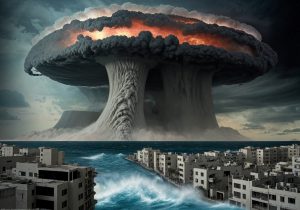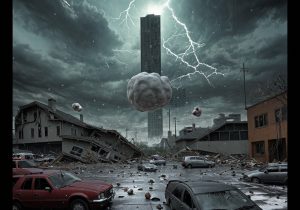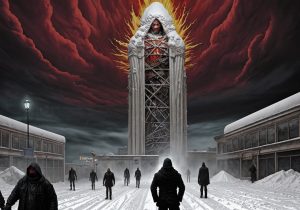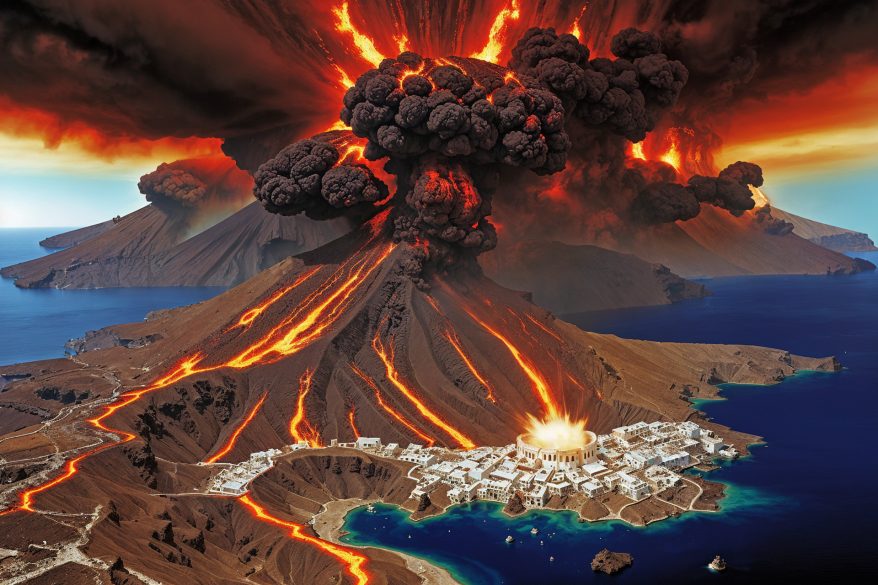A Silent Warning: Tremors Beneath the Aegean
You’re sipping coffee on a sunlit terrace in Athens when the first reports come in. 200 tremors in three days, all under the Aegean Sea near Santorini. Scientists assure the public that these are nothing more than a grumbling volcano stretching its legs.
The strongest quake—a mere 4.9 magnitude—rattles windows, but nothing serious. Social media fills with jokes about the island “waking up after 3,600 years.” But beneath the picturesque whitewashed houses, a beast is stirring.
A week later, the laughter stops.
A major earthquake strikes—magnitude 7.5.
The death toll stands at 53, with over 100 injured and 529 homes destroyed across the Cyclades. Landslides collapse roads. Tourists trapped on Santorini desperately scramble to evacuate. But this is just the prelude.
Then, the warnings come in: Santorini is about to erupt. And not just any eruption—this could be the most violent volcanic explosion in recorded history.
The Evacuation of 130 Million People
Scientists estimate that at least 130 million people across the Mediterranean are at risk—from tsunamis, ashfall, earthquakes, and toxic gas clouds.
Emergency sirens blare in Greece, Turkey, Italy, Libya, Egypt, Israel, and the Balkans. Governments order mass evacuations, but the warnings come late. Evacuating millions takes time.
And Santorini isn’t waiting.
The Eruption: A 2000-Megaton Detonation
On the fourth day of evacuations, at precisely 2:37 PM local time, the world ends for Santorini.
A colossal detonation—equivalent to 2,000 megatons of TNT—rips through the Earth’s crust. That’s ten times the force of Krakatoa (1883), nearly twice the power of an Apophis asteroid impact.
The caldera violently collapses. 100 cubic kilometers of ash, rock, and magma explode into the stratosphere.
A supersonic pyroclastic flow engulfs everything within 50 kilometers, turning the Aegean Sea into a boiling cauldron.
Then comes the tsunami.
The 150-Meter Megatsunami

At 2:45 PM, a 150-meter-tall tsunami—taller than a 40-story skyscraper—races across the Aegean at 800 km/h.
Within 8 minutes, the wave obliterates the northern coastline of Crete—just 110 km away.
Fifteen minutes later, it reaches Turkey and Egypt.
- Athens: The Acropolis is swallowed whole as 20-meter waves surge into the city.
- Alexandria: The Egyptian coastline vanishes under the sea.
- Istanbul: The Bosporus floods with seawater, submerging entire districts.
- Italy: Tsunami waves 30 meters high batter southern Italy and Sicily.
In just two hours, the Mediterranean has become an ocean of chaos.
Plagues, Blood Rivers, and Suffocation
You thought the worst was over? Not even close.
As the volcanic ash spreads, the world descends into biblical horror.
1. The Rivers Turn to Blood
The Nile, the Tiber, and every major river in the region turn blood-red as they mix with volcanic sulfates and iron oxides. Farmers and fishermen watch in horror as dead fish rise to the surface, poisoned by sulfuric acid.
2. The Frog Infestation
With rivers contaminated, millions of frogs flee the toxic waters, swarming cities in unprecedented numbers. But within days, they die en masse, their rotting bodies fueling an even worse catastrophe…
3. The Swarm of Flies
The dead frogs become breeding grounds for disease-ridden flies. Streets are blackened with swarming insects, spreading sickness through refugee camps and shelters.
4. A Locust Apocalypse
The eruption has triggered unprecedented rainfall, and with rain comes locusts. Billions of them, feeding on whatever remains of the Mediterranean’s crops.

5. The Hailstorms
Superheated volcanic ash seeds the clouds, creating catastrophic hailstorms. Hailstones the size of basketballs smash through homes and vehicles.
6. Darkness and Suffocation
The thick volcanic ash blocks out the sun. Within days, much of Europe, North Africa, and the Middle East are plunged into darkness.
The most horrifying part? CO₂ and sulfur dioxide—heavier than air—sink into valleys and low-lying cities. Millions suffocate in their sleep, unable to escape the invisible death creeping through the streets.
A New Ice Age? Global Cooling and Economic Collapse

The volcanic plume circumnavigates the globe within two weeks. The sheer volume of sulfur dioxide injected into the stratosphere triggers a global cooling event, with temperatures dropping by up to 2°C for years.
The consequences are devastating:
- Crop failures worldwide due to reduced sunlight.
- Famine spreads across Europe, the Middle East, and Asia.
- Stock markets collapse as global supply chains grind to a halt.
- Refugee crises destabilize governments as millions flee uninhabitable regions.
The Mediterranean—once the cradle of civilization—is now a zone of mass death and starvation.
Mitigation and Survival: Could We Have Stopped This?
The brutal reality? No.
Even with modern volcanic monitoring, early warning systems, and evacuation plans, the sheer scale of the eruption made survival a matter of luck.
What Could We Have Done?
- Stronger Evacuation Protocols
- If evacuations had started sooner, fewer lives would have been lost.
- Volcanic Engineering (Still theoretical)
- Some experts suggest artificially venting pressure from supervolcanoes could prevent catastrophic explosions. But the risks are immense.
- Geoengineering for Climate Stability
- A rapid increase in food reserves and climate mitigation strategies could soften the long-term consequences of global cooling.
Final Thoughts
Santorini’s Minoan Eruption (1600 BCE) wiped out one of the most advanced civilizations of its time. If history repeated itself today, the Mediterranean wouldn’t just suffer—the entire world would change forever.
Coming next: What If AI Dictators Ruled the World?

